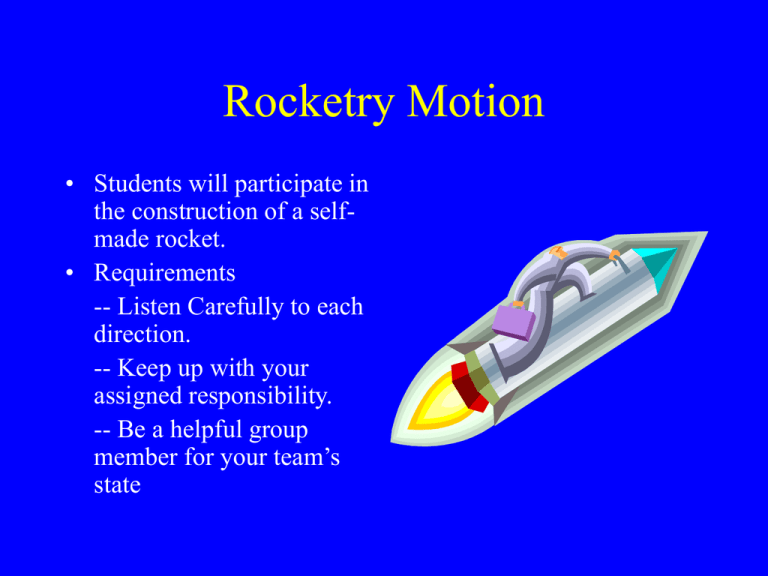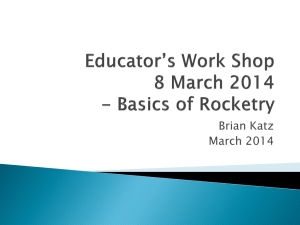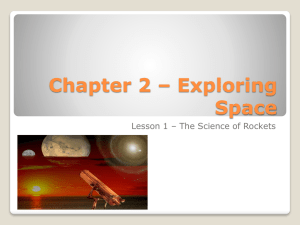Rocketry Motion
advertisement

Rocketry Motion • Students will participate in the construction of a selfmade rocket. • Requirements -- Listen Carefully to each direction. -- Keep up with your assigned responsibility. -- Be a helpful group member for your team’s state Who Builds the Rocket? • Each team is identified by a state. • Team’s will build rockets with their state logo and with each crewmember’s name carefully printed on the rocket’s fuselage. • Note: Fuselage is the technical name for the rocket’s main body. An aircraft also has a fuselage. What Will the Rocket be Made Out of? • General Materials Used are as follows: 1. Computer Paper 17. Future Items 2. Red Stick Tape 3. Corks 4. Balsa Wood 5. Large Paper Clip 6. Wood Tail Fins 7. Wood Glue 8. School Glue 9. Plastic Parachute 10. String 11. Plastic Streamer 12. Battery Charge 13. Paint 14. Engines, Contacts and plugs 15. Alligator Clips For Igniter 16. Water What Tools are Needed to Make the Rocket? • Tools Used: 1. 2. 3. 4. 5. 6. 7. 8. 9. Triangle & ¾’’ Circle Scissors Pliers Surgical or exacto Knife Wood Dowels Scales Sponges Sand Paper Meter/yard Stick When Will The Rockets Be Made • Now A Few Days Counting Launch and Post Lab. Where Will The Rockets Be Made • Mr. Mac’s Classroom Note: Prior to launching one of your team members may take the rocket home and paint it with model paint or spray paint. Verify with your parent. OSHA codes will not allow painting at school because certain kinds of paint contain hazardous materials that are dangerous to human health without proper protective gear. Why Will The Rockets Be Made • You have studied motion and Newton’s Laws a lot. • This lab will cover the areas studies as well as prepare you for other higher-order thinking science labs. • Team work is an important skill and to make a rocket exercises such skills. How Are The Rockets Made and Launched? Rockets will be made and launched by following a series of steps. First: Make the Body Tube. Next: Make your nose cone. Third: Make your engine retainer. Fourth: Prepare and install fins. Fifth: Rig parachute or streamer system. Sixth: Attach rocket to battery pack and launcher. How Are The Rockets Made? Rockets will be made by following a series of steps. Step 1:Get into your group and stay seated until everyone has found their group. Step 2: Each team starts with a piece of computer paper. How Are The Rockets Made? Step 3: Teams identify your materials in your state box and designate a student to put everything away during clean up. Show Mr. Mac when you are finished. Then return to your desk area and wait to be dismissed. Rocketry Construct Body Tube 4. Mark and cut your computer paper at 3 ¼ inches x 11 inches Rocketry Construct Body Tube 5. Take Your Wood Dowel and use it to roll the body of your rocket. You require school glue. Rocketry Construct Body Tube 6. Now, mark and cut a piece of red tape at 11 inches and moisten it. Roll the red tape to your rocket body. Rocketry Construct Body Tube 7. Mark and cut a piece of red tape at 18 inches. 8. Using the triangle, mark and cut your 45 degree angle. Rocketry Construct Body Tube 7. Moisten your 18 inch red tape and prepare to roll it over your body tube. 8. Remember to roll at a 45 degree angle and do not stop once you start. Rocketry Construct Body Tube 9. After your body tube has dried for 24 hours cut the red tape so that it is even with the computer paper. 10. Let Mr. Mac demonstrate how to make the cut before you make your cut. Nose Cone • Take small cork and large cork and using wood glue, glue the corks together. Let dry for 24 hours. • Safety: Groups must complete balsa wood cuts with Mr. Mac Observing. Nose Cone • • • • Using ¼ inch circle, mark out your balsa block. Leave your mark and very carefully slice the balsa Sand balsa as appropriate; make symmetrical Glue balsa with wood glue to cork and let sit for 24 hours. • DO NOT make nose cone smaller than body tube • Safety: Groups must complete balsa wood cuts with Mr. Mac Observing. Engine Retainer • • • • Get big paper clip! Straighten out paper clip! Bend with pliers attached to paper clip. Dimensions are listed below: 1¼ inches by 2¾ inches by ¼ inches. Tail Fins • Get three pre-cut tail fins! • Sand properly making a point on the trailing edge as well as the leading edge! • Sand about half way through on each side down to a point. Paint them for less air resistance attach to body tube with wood glue using template. Tail Fin Template • Take a piece of computer paper • Make the following marks: ¾ Inch Circle ☆Glue tail fins to the 120 degree marks. Let glue dry for 3 min before applying. 120 Degrees Install Engine Retainer. • Use retainer to hold engine in place. • Using 3/16” drill make hole approximately 2 ¾” up from the bottom of the body tube • Drill completely through the body tube • Do not drill into a tail fin. Body Tube ¼” side of engine retainer. 2 ¾” side of engine retainer. If too short or long, adjust with fingers so it fits. Drill Hole For 1 ¼” Engine retainer side Install Rocket Motor • Use retainer to hold engine in place. • Engine contacts are connected to the motor in the following way: • Slide motor in tube and plug (yellow) contacts so they are positioned against engine explosives. Plug Contacts that will connect to alligator clips. Bottom View of Rocket Engine Rocket Motor Info. • Motor burn for two 3 second spans. • Burn one: Propels rocket off ground. • Burn two: Explodes causing an exothermic reaction inside the body tube. • Explosion causes nose cone to pop out and recovery system to deploy. Build Recovery System Materials String Rubber band 1” x 18” streamer 1” x 1” square piece of paper School Glue Build Recovery System Procedure: ★ Cut two pieces of 10” string ★ Place drop of glue in center of 1” by 1” paper. Fold in half with end of string positioned in center. Place second drop on ½” by 1” paper and fold again making a ¼” by ¼” attachment base. Attachment Base Glued inside Body Tube Build Recovery System Procedure: ★ Tie string that has attachment base to one side of a rubber band with a surgeon’s knot followed by a square not. Trim to 1/8”. ★ Tie second string to other side of the same rubber band using a surgeon’s knot followed by a square knot. Trim to 1/8”. Attachment Base Rubber band Streamer Build Recovery System Procedure: ★ Roll streamer up using a pencil. Do not place in body tube until pre-launch inspection. ★ Glue attachment base to inner side of body tube. Let dry for at least 1 hour. Attachment Base Body tube Rubber band Streamer Build Recovery System Procedure: ★ Using hot glue gun, glue a 1 ½” Piece of a straw to the side of the body tube. ★ Tip: Make sure that the igniter contacts are routed on the opposite side of the body tube’s straw. Body Tube Straw Build Recovery System Procedure: ★ Make Streamer: Cut out a piece of plastic that is 1” x 18” in length and using masking tape attach your recovery lanyard to the side that is opposite to the attachment base. 3 pieces of masking tape Streamer 1” 18” Recovery Lanyard Build Recovery System Procedure: ★ Make Streamer: Cut out a piece of plastic that is 1” x 18” in length and using masking tape attach your recovery lanyard to the side that is opposite to the attachment base. 3 pieces of masking tape Streamer 1” 18” Recovery Lanyard Pre Launch Inspection 1. Cut a ¾” square of wadding and carefully push it well into the body tube. Note: Never use toilet paper or tissue paper; they are flammable.The wadding is a barrier designed to keep from burning up your recovery system and nose cone. Pre Launch Inspection 2. One person represents the team and sits at the lab table with rocket in front. 3. On teacher’s command, the engines are inserted in the body tube and tightened in by adjusting the engine retainer. Pre Launch Inspection 4. Then, the teacher assists students installing igniter contacts and yellow plugs. 5. Next, students carefully place their rolled streamer and recovery system into the body tube. 6. Last, students carefully place their completed rockets into a cargo box that the teacher will use to transport rockets to launch pad. Model Rocketry Safety Code 1. Construction—My model rocket will be made of lightweight materials such as paper, wood, plastic and rubber. Without any metal as structural parts. 2. Engines—I will use only pre-loaded factory made model rocket engines in the meaner recommended by the manufacturer. I will not change in any way nor attempt to reload these engines. 3. Recovery—I will always use a recovery system in my rockets that will return them safely to the ground so that they may be flown again. Model Rocketry Safety Code 4. Weight Limits—My model rocket will weigh no more than 453 grams (16 oz) at lift off. And the engines will contain no more than 113 grams (4 oz) of propellant. 5. Stability—I will check the stability of my model rockets before their first flight except when launching models of already proven stability. 6. Launching system—The system I use to launch my model rockets must be remotely controlled and electrically operated and will contain a switch that will return to “off” when released. I will remain at least 20 feet away from any rocket that is being launched. Model Rocketry Safety Code 7. Launch safety—I will not let anyone approach a model rocket on a launcher until I have made sure that either the safety interlock key has been removed or the battery has been disconnected from my launcher. 8. Flying conditions—I will not launch my model rocket in high winds, near buildings, power lines, tall trees, low flying aircraft. Or under any conditions which might be dangerous to people or property. 9. Launch Area—My model rockets will always be launched from a clear area free of any easy to burn materials and I will only use nonflammable recovery wadding in my rockets. Model Rocketry Safety Code 10. Jet Deflector—My launcher will have a jet deflector device to prevent the engine exhaust from hitting the ground directly. 11. Launch Pad—To prevent accidental injury I will always place the launcher so the end of the rod is above eye level or cap the end of the rod with my hand when approaching it. I will never place my head or my body over the launching rod. When my launcher is not in use I will always store it so that the launch rod is set in an upright position. 12. Power Lines—I will never attempt to recover my rocket from a power line or other dangerous place. Model Rocketry Safety Code 13. Launch Targets & Angle—I will not launch rockets so their flight path will carry them against targets on the ground and will never use an explosive warhead nor a payload that is intended to be flammable. My launching device will always be pointed within 30 degrees of vertical. 14. Pre-Launch Test—When conducting research activities with unproven designs or methods, I will when possible determine their reliability through pre-launch tests. I will conduct launchings of unproven designs in complete isolation from persons not participating in the actual launching. Launch Procedure 1. Students line up on sidewalk and face woods. 2. Teacher watches wind direction and attempts to keep rockets within field area 3. Recovery teams will collect rockets after they have landed, NEVER BEFORE! Launch Procedure 4. Students must remain 20 feet from the rocket. 5. Student team leader will push the launch button on the signal. NOTE: When pushing the button, Push and count…1, 1000, 2, 1000, 3. The button must be pressed for at least 2 seconds. 6. Do not quickly press the button like a gun’s trigger. There will not be enough time to initiate the igniter. Launch Procedure 7. The rocket is on the stand and the students must shout 5, 4, 3, 2, 1 and blast off. At that precise moment, the button is pressed for at least a 2 second duration. 8. Safety key not used until everyone is listening and ready. Launch Contest 1. Time rocket spends airborne. 2. Altitude data if available. How Does a Model Rocket Work? 5. Apogee 6. Streamer or Parachute Ejection 4. Coasting Period Rocketry 3. Burnout 2. Lift Off 1. Ignition 7. Soft Landing Assignment • Teams will gather the time durations of the other rockets and make bar graphs that reflect each rocket’s status. • Winning team gets a small prize. • All teams get to keep rockets. Rockets are to be taken home by team elected student. Rocketry Lab Quiz • Fill in the blank quiz. • 1. When making a paper rocket, how many pieces of paper are used? _________. • 2. How many pieces of red tape were used? _________. • 3. What was used to hold the engine in place? _________. Rocketry Lab Quiz • Fill in the blank quiz. • 4. When making your rocket what did you glue to the bottom of your nose cone? _________. • 5. When describing a tail fin you know that the leading edge is in front, what do you call the edge on the bottom? ________________________. • 6. What type of glue was used to attach the tail fins to the rocket’s body tube? ____________. Rocketry Lab Quiz • Fill in the blank quiz. • 7. When you used the triangle, how many degrees did you mark the second piece of red tape before you made your cut? _________. • 8. What caused the rocket’s engine to ignite? ______________________________________. • 9. What was the name of the system that the rocket used on its way down to the ground? ______________________________________. • 10. If each block had 8 teams and there are 5 blocks, how many teams were there in all? ____.








